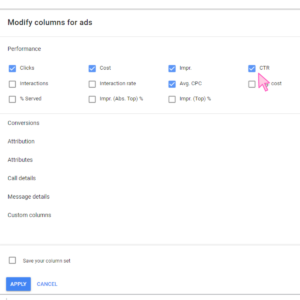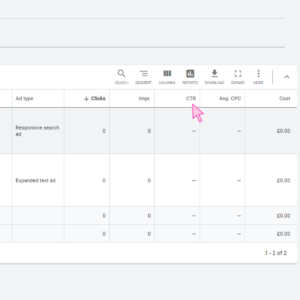Ways To Improve ROAS In GoogleAds


Looking for ways to improve ROAS in your GoogleAds campaigns? Then look no further! Whether you are struggling to generate a return on your campaigns or don’t even know where to start/what to look for, this article will take you through the data you should consider looking at and why to get you on the path to a successful campaign.

When it comes to any form of advertising, our ultimate goal is to generate a return on investment. Of course we all know this is easier said than done and if there was a way to improve ROAS in GoogleAds with little to no effort, everyone would be doing it!
GoogleAds is a platform where you are actively choosing to make an investment, in the hope that from this you sell more of your products or services.
I often have many clients ask me: “How can I improve my ROAS in GoogleAds when it is so expensive?”
With GoogleAds search campaigns, you are actively bidding to position for certain keywords on Google’s search network. As you are paying for this positioning, you generate traffic and data at a much faster rate. When taking this into consideration, in order to improve your ROAS in GoogleAds, it is incredibly important that you are optimising your campaigns to be as cost effective as possible.
Your campaigns could be built to follow all of the best practices and feature highly relevant targeting, but if they aren’t being optimised/monitored, performance can only go so far!
What is ROAS?
Within Google Ads ROAS is also displayed as Conv.Value/Cost. ROAS stands for “return on ad spend” and is probably one of the most important metrics to be monitoring within your account, if the data is available.
Metrics To Monitor & How To Improve On Them
Monitor CTR (Click-Through Rate)
Definition: The number of clicks that your ad receives divided by the number of times that your ad is shown
Whilst ctr isn’t exactly going to get you a return on ad spend. It is important to consider when it comes to getting traffic to your site and understanding what adcopy is the most appealing. If your ctr is too low, not only could this have a negative impact on brand awareness, but you could be missing out on valuable clicks which had the potential of turning into conversions. You can monitor your ads ctr within the platform, in the columns alongside your ads.


Work On Your Conversion Rate
Definition: The average number of conversions per ad interaction, shown as a percentage.
Reviewing what requires less clicks in order to generate conversions will allow you to identify the most conversion friendly areas within your account. Whether that be campaigns, ad groups, keywords, devices etc.
Identifying these areas is incredibly helpful when you are trying to figure out where to push more spend. Applying your budget share to be cost effective is key when you are trying to improve your ROAS in GoogleAds.
In theory, if you are pushing your spend towards campaigns that require less clicks to generate a conversion, they have the potential to receive more conversions within your budget share than campaigns that typically require a larger volume of clicks in order to convert.
What Is Your Cost Per Acquisition (CPA)?
Definition: The average amount that you’ve been charged for a conversion from your ad.
This is one of the most, if not, the most important metric that has an impact on ROAS. Let’s say you have both a high click-through rate and conversion rate, that’s great! HOWEVER, despite this, you are spending a large amount in order to get that conversion, this is not so great. Especially in the instance you are paying more to acquire a conversion than your actual product or service. Whilst conversion rate can affect CPA, other factors such as CPC can have a massive impact as well.
When taking the above into consideration, in order to optimise your CPA performance, you would need to consider the following aspects in your optimisation plan:
- Do you need to work on improving your keyword quality score to reduce your CPC?
- Is your keyword targeting too broad or competitive and are there any longtail/less competitive variations you could be bidding for instead?
- Are you effectively utilising your budget share? I.e. actively identifying the areas where your cpa is low and pushing more spend here.
Review Your Bounce Rate

Definition: The percentage of visitors to a particular website who navigate away from the site after viewing only one page.
If users are getting to your site and instantly clicking off, you run the risk of wasting a lot of budget. When it comes to GoogleAds, your keywords have the job of targeting the relevant audience, your ads have the job of generating the click and your website’s job is to land that conversion. You can have the most persuasive ad copy in the world, coupled with highly relevant targeting, but if your website isn’t convincing to the user, it almost renders this irrelevant.
Struggling with a high bounce rate? Consider looking into the following:
- Is the viewer being taken to a relevant page?
- Is your page optimised for PPC?
- Is your website optimised for mobile phones?
- What is your site speed?
When you are unsure about your landing page, the best thing you can do is split test it with another page. GoogleAds allows you to create campaign experiments, which are a great way to test page performance without impacting your original campaign during the testing process.
Abandonment at Checkout
This primarily applies to eCommerce, nonetheless is still very important to monitor. Let’s say you have captured the perfect formula when it comes to targeting, ad copy AND your landing page. Users are taken to your site, enthused about your product and ready to checkout, but are met with an incredibly complicated or buggy checkout process. Suddenly their enthusiasm drops and the bad news is, they have abandoned their cart. Sounds like a nightmare right? Well the good news is this is both trackable and fixable, providing you identify the issue.
Once you have addressed the complications with the checkout process on your site, you can then remarket to those basket abandoners with campaign types such ads dynamic remarketing, to recapture their interest and land that conversion.
Red flags which may be impacting your checkout completions:
- Is the checkout button is hard to find or does the user have to go through a number of steps and/or pages to checkout?
- Does the user have to enter too many details, making it a hassle to checkout?
- Is the user expected to sign up to a mailing list in order to checkout?
- Does the checkout process take a long time to load, frequently freezes or users are taken to a 404 page?
- Do you have a checkout that is not optimised for mobile phones?
Attribution/Multi-Channel Conversions
Attribution Definition: The process of assigning credit for sales and conversions to touchpoints in conversion paths.
Often PPC is the first point of contact between your business and the consumer. Meaning the likelihood of them converting upon visiting your site for the first time is relatively low. This is where attribution comes in and it’s often wrongfully overlooked. Identifying what sources/mediums drive the initial interest or play an active role in the path to purchase, can be a catalyst in allowing you to understand where you could be both utilizing spend and pushing your efforts.
Attribution allows you to look further than just surface level data and prevents you from making the assumption that your campaigns aren’t working just because they are not generating direct conversions. In reality they could be playing a vital role of building brand awareness and may be the driving force of branded conversions.
The best way review your attribution data for all of your mediums is to go into your Analytics account and from there go to “conversions” followed by “Multi-Channel Funnels.”

Bidding Strategies That Align Great With Improving ROAS In GoogleAds
Target CPA: This is where you would apply what you are willing to pay to acquire a conversion and using machine learning Google will try and achieve this goal.
Target ROAS: This is where you can apply a specific ROAS goal that you would like to achieve as a percentage (i.e. 400%) and using machine learning Google will try and achieve this goal.
I must stress that for the above to be possible to measure, you must be tracking your campaigns. Without tracking you face the high possibility of wasting precious ad spend that you could be using elsewhere.
Google Analytics is a great way to monitor performance, not only for GoogleAds, but for all mediums. It is here where you can also identify drop-off pages on your site, bounce rate and abandonment at checkout.
Conclusion
To conclude this article, generating an ROAS is certainly achievable. This is providing you have not only implemented a strong campaign build initially, but you are actively monitoring/optimising your campaigns. PPC is a process that takes time and will not always work instantly, whilst it does seem overwhelmling, however an outcome that reflects your hard work will open many opportunities to scale your business.



One Comment
Pingback: